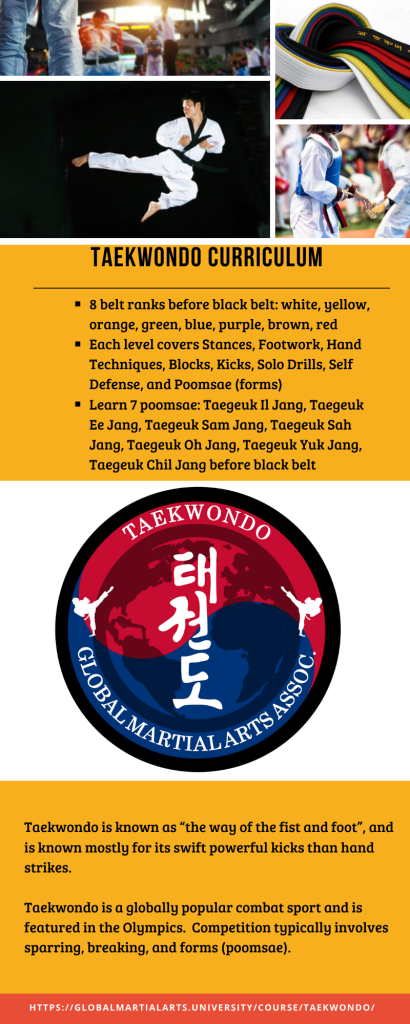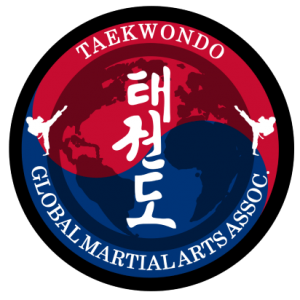Taekwondo is a Korean martial art that’s well known among the general population worldwide. The word “Taekwondo” consists of three parts: “tae”, meaning foot, “kwon”, meaning fist or hand, and “do”, meaning way.
Although Korea has had its own native martial arts for thousands of years ̶ Taekwondo, as we know it today, originated in the 1950s. In this article we provide a concise history of Taekwondo from the 1950s to present, from the original kwans to World Taekwondo.
What is Taekwondo?
Taekwondo is a Korean martial art that focuses on striking techniques, including kicks, punches, and blocks. It’s well known for its emphasis on high, fast kicks and dynamic movements. It includes various forms (patterns of movements), sparring, and self-defense techniques.

Source: Adobe Stock
Author fovivafoto
Taekwondo is predominantly known today as an Olympic Sport. However, it has long been a part of military hand-to-hand combat training for Republic of Korea (ROK) solders, as evidenced here. During the Vietnam War, the ROK Tiger Division was respected by American GIs and feared by the Viet Cong. Learn more about the ROK Tiger Division and their Taekwondo training via a two-part Black Belt magazine article series here and here.

Source: Wikimedia Commons
Author: Ed Scott
Taekwondo is characterized by its focus on high, powerful kicks, rapid footwork, and dynamic movements. It places a strong emphasis on kicking, flexibility, balance, and agility. Taekwondo also makes use of hand techniques such as punches, blocks, and strikes.

“It is a lonely 15-mile drive from this coastal Vietnamese city to the main camp of the Republic of Korea (ROK) Tiger Division.
But the trucks of the Koreans don’t carry the machine guns and heavy armament that most forces consider necessary for survival in a country where ambushes are a dime a dozen.
The reason is simple: The Viet Cong have learned better than to fool with the 15,000-man Tiger Division, a group which has established itself as one of the world’s toughest fighting machines in a little less than a year on the job.
I have marched with virtually every major American and Vietnamese unit. None of them impressed me as much as the Koreans. They really are tigers.”
Remarks made by the Hon. Spark M. Matsunaga (Senator and Congressman from Hawaii), reporting from on-the-ground sources to U.S. The House of Representatives on April 27, 1966. Congressional Record Appendix A2286 – Published on CIA FOIA (foia.cia.gov)
Additionally, Taekwondo places great importance on discipline, respect, and the development of mental strength alongside physical skills. It’s often practiced in a formal and structured manner, with practitioners progressing through colored belt ranks as they improve their skills and knowledge.
Taekwondo Kwans
In the past, some claimed that Taekwondo had origins thousands of years ago. With the advent of easily accessible digital information, such claims have been proven false. What is now called Taekwondo largely originated between the 1940s-1960s. In fact, most of the founders of the original 5 kwans trained in Japanese karate (predominantly Shotokan). Some founders were exposed to, or also trained in, Chinese kung fu via personal travels or military service. For a more in-depth information on this topic, refer to the 5-part series, on the history of Taekwondo, produced by FightingArts.com: Part 1, Part 2, Part 3. Part 4, Part 5a, and Part 5b.
The only “ancient” influences on the development of Taekwondo come from very old, indigenous Korean martial arts, such as Taekkyeon , an indigenous combat sport, and Kwon Bup (alternately Romanized as Gwonbeop), the empty-hand fighting techniques found in the Muyedobotongji, a 4-volume, Chinese-influenced, field manual of 24 specific military skills.
Taekwondo kwans refer to the original schools or styles, which would later be called “Taekwondo”, that were developed after World War II in South Korea. Each kwan had its own unique approach to training and techniques. The kwans played a significant role in the development and standardization of modern taekwondo.
There were 3 phases of Taekwondo kwans: the “original” kwans, the “nine kwans”, and a third phase of splintering that added 3 more styles of Taekwondo. The kwans laid the foundation for what would eventually become modern taekwondo. Over time, these individual styles were unified and standardized into the single martial art we recognize today as Taekwondo.

Image Source: taekwondo.wikia.com
Author: Truejim
The 5 “Original” Kwans
The five original kwans are:
- Chung Do Kwan: Founded by Lee Won Kuk in 1944. It emphasized a combination of Shotokan karate and traditional Korean martial arts.
- Moo Duk Kwan: Founded by Hwang Kee in 1945. It incorporated elements of Shotokan karate and indigenous Korean martial arts.
- Yun Moo Kwan: Founded by Yoon Byung-in in 1946. It was known for its unique kicks and emphasis on strong stances.
- Chang Moo Kwan: Founded by Ro Byung Jick in 1946. It focused on a combination of traditional Korean martial arts and Shotokan karate.
- Ji Do Kwan: Founded by Chun Sang Sup in 1946. It incorporated a mixture of Shotokan karate, Chinese martial arts, and traditional Korean martial arts.
Kwan/Style Expansion

Image Source: taekwondo.wikia.com
Author: Truejim
The phrase “9 Kwans” refers to the original 5 schools PLUS 4 major schools that opened after the conclusion of the Korean War. The 4 newer kwans included:
- Han Moo Kwan: Founded in August 1954 by Lee Kyo Yoon as an offshoot of the Yun Moo Kwan/Jidokwan.
- Oh Do Kwan: Founded in 1955 by Choi Hong Hi, who also became honorary head of the Chung Do Kwan.
- Kang Duk Won: Founded in 1956 by Park Chul Hee and Hong Jong Pyo as an offshoot of the Kwon Bop Bu/Chang Moo Kwan.
- Jung Do Kwan: Founded in 1956 by Lee Yong Woo as an offshoot of the Chung Do Kwan

Source: Original Image
Author: Joel E. Williams
Three additional “styles” splintered from the 9 Kwans:
- Jhoon Rhee Stye Taekwondo: Founded in 1957 by Jhoon Rhee as an offshoot of the Chung Do Kwan, headquartered in the United States.
- International Taekwondo Federation (ITF): Founded in 1966 by General Choi Hong Hi Vienna, Austria upon his exile from South Korea.
- American Taekwondo Association (ATA)/Songahm Taekwondo: Founded in 1969 by Haeng Ung Lee, headquartered in the United States.
The Rise of WT

World Taekwondo (WT) is the international governing body for the sport of taekwondo. Formerly known as the World Taekwondo Federation, it was established in 1973 and is responsible for promoting and organizing taekwondo competitions and events on a global scale.
WT sets the rules and regulations for taekwondo competitions, including the Olympic Games, where Taekwondo has been an official Olympic sport since the 2000 Sydney Olympics.
WT’s mission includes fostering the growth and development of taekwondo worldwide, promoting the values of respect, self-discipline, and fair play, and providing a platform for athletes of all levels to compete and showcase their skills.
It also plays a role in promoting gender equality and inclusivity within the sport.
WT organizes various tournaments, including World Taekwondo Championships and World Taekwondo Grand Prix events, which attract top Taekwondo athletes from around the world.
Kukkiwon

Kukkiwon is responsible for standardizing Taekwondo techniques, providing instructor certifications, and organizing events and competitions in collaboration with World Taekwondo (WT).

Source: Wikimedia Commons
Author: Truejim
The Kukkiwon is the official headquarters of the World Taekwondo Federation (WT) and the center for taekwondo education and training. It’s located in Seoul, South Korea, and serves as a hub for promoting and developing the sport of Taekwondo internationally.
The GMAU TKD Program
Interested in learning Taekwondo? Check out the GMAU Taekwondo program here!
By the way: the GMAU Taekwondo curriculum aligns with WT standards. That means that any GMAU Taekwondo student can join and certify their rank through the Kukkiwon!

Set up a FREE Beginner’s Account and start training TODAY!










Pingback: All News At Finger Tips – A Brief History of Taekwondo – Global Martial Arts University
Pingback: A Transient Historical past of Taekwondo – World Martial Arts College - Personal Safety News
Pingback: The Rise of World Taekwondo – Global Martial Arts University
Pingback: All News At Finger Tips – The Rise of World Taekwondo – Global Martial Arts University
Pingback: The Rise of World Taekwondo – International Martial Arts College - Sports Champ. All rights reserved.
Pingback: The Rise of World Taekwondo – World Martial Arts College - Worldwide News